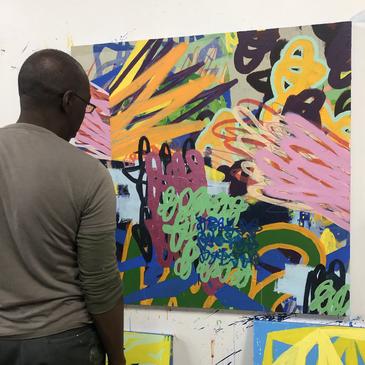
Tim McFarlane
January 19, 2023
by Laura Sallade
Philadelphia-based painter, Tim McFarlane is making meaning with the language of abstraction. Visually distinct, his work draws on a wide range of colors and mediums, layering opaque gestures which he calls “glyphs”, along with various modes of scribble-like marks. Referencing linguistics and inciting an impulse to read the work, these glyphs are, in fact, illegible. In the late 90’s, language-adjacent symbols began to take shape in his sketchbooks. In the early 2000’s, art-writers such as Roberta Fallon and Lilly Wei compared his work with Sean Scully's—a connection which today would be a stretch. The glyphs made elusive appearances in his work from 1999 on, but only became a prominent feature in 2018 when he publicly exhibited them in a ceiling panel installation at The Philadelphia International Airport. These graffiti-like glyphs have a clear orientation and are generated randomly. Staying true to what the piece requires, Tim paints some marks with a slow and pensive application, but the rapid appearance of the glyphs is often true to form.
Tim’s studio holds a tenuous balance between order and chaos. Countless works, finished or in process, occupy the walls, floor, and storage shelves. Paint-filled carts and book-filled bins gave the sense that Tim knows exactly where to find what he needs, but don’t send anyone else looking for those items. Titled “Seen and Heard: Today/Tomorrow/Forever”, a ten by twelve foot painting leaned against the wall. The physicality of the piece conveyed the artist’s authenticity—the way he honors each moment of the process by engaging with the surface in an unbridled manner. In any given painting, there may be five potential paintings below the final product, which he arrives at when it “feels right.” Drawing on drafting paper which he layers into the surface, he adds a hint of collage and translucency to his language of mark-making. Most artists who work in layers, like myself, use a high level of translucency to give their original layers prominence, but McFarlane sets himself apart, prescribing an indiscriminate willingness to cover former marks with a bold opacity. He does not feel a sense of loss about the paintings beneath—for this process artist, it’s all gain.
In the 80s when Tim was starting out, he noticed that his African American peers were often relegated to certain exhibitions—mostly figurative work that spoke to the struggle of the black experience. The artist intuitively recognized this boxing in as a mere mutation of former societal limitations, and rebelled by delving into still-lives and landscapes, focusing on color mastery. This often unspoken expectation for black artists is an old tune that has been playing on repeat for decades. In the late 60s and early 70s, a group of black artists including Sam Gilliam, Howardena Pindell, Al Loving, William T. Williams, Frank Bowling, and Joe Overstreet came into prominence by focusing on the formal elements of abstraction. At times, these artists received criticism for not overtly engaging with the political discourse, and were set against their African American contemporaries, like Dana Chandler, Jeff Donaldson, Nelson Stevens and Wadsworth Jarrell, who were making recognizably political work which was sometimes viewed as the genuine depiction of the black experience.
“All good art is political!” said Toni Morrison. Not that by being political, the work is automatically good, but by being good, it is automatically political. While being an artist (especially for African Americans) is a political act in and of itself, these abstract predecessors and contemporaries alike manifest a resistance to the status quo by making work that denies its viewers the comfort of a work easily metabolized. Gilliam, for example, was subverting the way society expected a painting to behave, while today McFarlane is proclaiming an ideal of expansiveness. His broad gestures push beyond the picture frame, working in tandem with an extensive palette to reveal his philosophy of life. Moreover, according to Tim, he feels the most freedom in his works on paper, which he calls his “playground.” Repurposing old Euro-centric gardening books from the 1950s and 60s, the artist collages over refined imagery, imposing his glyphs upon them, and employing abrasive techniques which wear out the original surface.
Rarely making sketches for his large works, the artist completes every piece with a confident autonomy. Having built a strong practice, he works on multiple pieces at once—any work may provide occasional reference points for the next, as he goes directly to panel, resolving each piece in real time. Through massive outlined scribbles, straight line breaks, and loose brushy marks that are almost entirely buried, McFarlane communicates a pulsating liberation, a compounded record of memory, and a near sonic visual expression of his life. Between spurts of rapid application, he steps back and thinks about the next move for as long as it takes—no one can rush him. By putting his intuition and process first, Tim has abolished unspoken expectations and established a fluid integration of intuition and cerebral thought—an authentic interweaving of his memories, his aesthetic convictions, the present moment, and of freedom itself.
